
 (732) 246-1377
(732) 246-1377
 (732) 246-1377
(732) 246-1377
Foot care is important regardless of your profession, but those who work on their feet must pay special attention. Bunions, calluses, blisters, and plantar warts are just a few of the many conditions that can arise after standing all day. While painful at their worst, these conditions can easily be avoided with the right foot care. This includes both appropriate footwear and proper posture—important elements that affect the health of your feet.
Choosing appropriate footwear means choosing a shoe that has a negative heel. This means that the heel is slightly lower than the ball of your foot, which places less of a strain. If you have a profession that requires you to be on your feet all day, investing in a pair of high-quality shoes is pertinent. High-quality shoes can be purchased from a respected manufacturer that emphasizes foot care and foot health.
Despite the regularity of wearing shoes, the feet are naturally not designed to be enclosed. Regular “barefoot” time for your feet can be beneficial for foot health. Among other methods, allowing your feet to breathe can help alleviate the pain and pressure your feet may be experiencing from being on your feet all day.
Simple foot exercises and yoga positions can help improve both the health and function of your feet. Active foot exercises that create movement will stimulate your foot’s blood flow and circulation, and yoga positions that place your feet flat onto the floor will stretch out their muscles. Yoga is particularly beneficial for your Achilles tendon and calf muscles, which are areas that can become especially problematic if not taken care of. Foot exercises and yoga positions can be easily performed every day at virtually any location and any time; whether it is at the office, at the gym, or at home right before you go to bed. Simple stretching can increase your foot health by miles.
The foot pain you experience after lengthy hours working on your feet may seem inevitable and unavoidable; in reality, however, that is not the case. Wearing proper footwear and performing simple foot exercises and stretches can help ease foot pain and allow you to truly avoid frustrating foot problems.
Your feet can easily be kept healthy with some education and a little effort. Pain that begins at the feet can eventually affect the whole body. Begin taking care of your feet now!
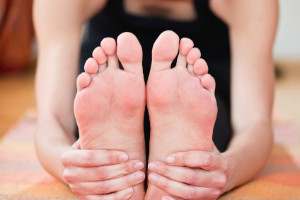 There is a close relationship between the muscles in the legs and those in the feet. If there is pain in the leg muscles, it can make it difficult for the muscles in the foot to do their job. It is beneficial to stretch the foot muscles to keep your feet fit and healthy. An effective stretch is called “the tendon stretch”, where the heels extend beyond the edge of a step. Another common stretch is called “the knee hug”, where you cross one knee over the other, and "hug" that knee toward your chest. These are a few of the many stretching techniques for your feet and legs. If you feel pain in your feet while stretching, it is recommended that you stop immediately and see a podiatrist for treatment.
There is a close relationship between the muscles in the legs and those in the feet. If there is pain in the leg muscles, it can make it difficult for the muscles in the foot to do their job. It is beneficial to stretch the foot muscles to keep your feet fit and healthy. An effective stretch is called “the tendon stretch”, where the heels extend beyond the edge of a step. Another common stretch is called “the knee hug”, where you cross one knee over the other, and "hug" that knee toward your chest. These are a few of the many stretching techniques for your feet and legs. If you feel pain in your feet while stretching, it is recommended that you stop immediately and see a podiatrist for treatment.
Stretching the feet is a great way to prevent injuries. If you have any concerns with your feet consult with one of our podiatrists from Livingston Footcare. Our doctors will assess your condition and provide you with quality foot and ankle treatment.
Stretching the Feet
Being the backbone of the body, the feet carry your entire weight and can easily become overexerted, causing cramps and pain. As with any body part, stretching your feet can serve many benefits. From increasing flexibility to even providing some pain relief, be sure to give your feet a stretch from time to time. This is especially important for athletes or anyone performing aerobic exercises, but anyone experiencing foot pain or is on their feet constantly should also engage in this practice.
Great ways to stretch your feet:
Individuals who tend to their feet by regular stretching every day should be able to minimize foot pain and prevent new problems from arising.
If you have any questions, please feel free to contact our office located in North Brunswick, NJ . We offer the newest diagnostic and treatment technologies for all your foot care needs.
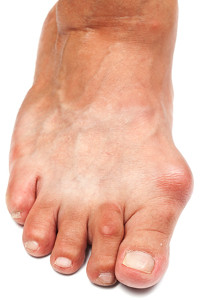 A bunion is a deformity that occurs on the joint at the base of the big toe. Though the exact cause of bunions is somewhat disputed, wearing tight fitting shoes and genetics tend to play a role in the development and exacerbation of them. Common symptoms that are usually associated with bunions include swelling, soreness, pain, and redness around the joint and bump. Bunions can become worse over time, and poorly-supportive footwear, like high heels, have been associated with worsening them. It is recommended to see a podiatrist when you notice a bunion forming even when it does not cause pain. If you have a bunion that is causing you pain, you should see one right away. A podiatrist will generally offer non-surgical options first if the bunion is not severe. These include bunion pads to relieve pressure off the bunion, pain and anti-inflammatory medication, and suggesting roomier shoes. If the pain continues or worsens and all non-surgical options have failed, surgery may be considered.
A bunion is a deformity that occurs on the joint at the base of the big toe. Though the exact cause of bunions is somewhat disputed, wearing tight fitting shoes and genetics tend to play a role in the development and exacerbation of them. Common symptoms that are usually associated with bunions include swelling, soreness, pain, and redness around the joint and bump. Bunions can become worse over time, and poorly-supportive footwear, like high heels, have been associated with worsening them. It is recommended to see a podiatrist when you notice a bunion forming even when it does not cause pain. If you have a bunion that is causing you pain, you should see one right away. A podiatrist will generally offer non-surgical options first if the bunion is not severe. These include bunion pads to relieve pressure off the bunion, pain and anti-inflammatory medication, and suggesting roomier shoes. If the pain continues or worsens and all non-surgical options have failed, surgery may be considered.
If you are suffering from bunions, contact one of our podiatrists of Livingston Footcare. Our doctors can provide the care you need to keep you pain-free and on your feet.
What Is a Bunion?
A bunion is formed of swollen tissue or an enlargement of boney growth, usually located at the base joint of the toe that connects to the foot. The swelling occurs due to the bones in the big toe shifting inward, which impacts the other toes of the foot. This causes the area around the base of the big toe to become inflamed and painful.
Why Do Bunions Form?
Genetics – Susceptibility to bunions are often hereditary
Stress on the feet – Poorly fitted and uncomfortable footwear that places stress on feet, such as heels, can worsen existing bunions
How Are Bunions Diagnosed?
Doctors often perform two tests – blood tests and x-rays – when trying to diagnose bunions, especially in the early stages of development. Blood tests help determine if the foot pain is being caused by something else, such as arthritis, while x-rays provide a clear picture of your bone structure to your doctor.
How Are Bunions Treated?
If you have any questions, please feel free to contact our office located in North Brunswick, NJ . We offer the newest diagnostic and treatment technologies for all your foot care needs.
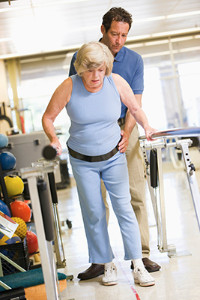 A new study by the University of Waterloo says that the elderly need up to twice as long as young adults to realize they are falling. Seniors are already at an increased risk of falling due to a number of reasons. This study helps show that once they are falling, they don’t process it as quickly as a younger person would. Consequently, there are more times that seniors can’t react fast enough to catch themselves or brace for impact. Falls are a leading cause of hospitalization among the elderly. Studies like this and increased awareness are needed to help prevent future falls among this rapidly growing group of people.
A new study by the University of Waterloo says that the elderly need up to twice as long as young adults to realize they are falling. Seniors are already at an increased risk of falling due to a number of reasons. This study helps show that once they are falling, they don’t process it as quickly as a younger person would. Consequently, there are more times that seniors can’t react fast enough to catch themselves or brace for impact. Falls are a leading cause of hospitalization among the elderly. Studies like this and increased awareness are needed to help prevent future falls among this rapidly growing group of people.
Preventing falls among the elderly is very important. If you are older and have fallen or fear that you are prone to falling, consult with one of our podiatrists from Livingston Footcare. Our doctors will assess your condition and provide you with quality advice and care.
Every 11 seconds, an elderly American is being treated in an emergency room for a fall related injury. Falls are the leading cause of head and hip injuries for those 65 and older. Due to decreases in strength, balance, senses, and lack of awareness, elderly persons are very susceptible to falling. Thankfully, there are a number of things older persons can do to prevent falls.
How to Prevent Falls
Some effective methods that older persons can do to prevent falls include:
Falling can be a traumatic and embarrassing experience for elderly persons; this can make them less willing to leave the house, and less willing to talk to someone about their fears of falling. Doing such things, however, will increase the likelihood of tripping or losing one’s balance. Knowing the causes of falling and how to prevent them is the best way to mitigate the risk of serious injury.
If you have any questions, please feel free to contact our office located in North Brunswick, NJ . We offer the newest diagnostic and treatment technologies for all your foot care needs.
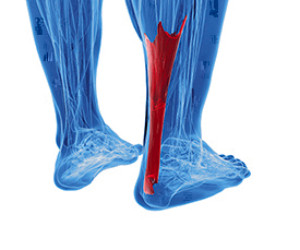 Basketball player Sheldon Mac of the Wizards has recently torn his left Achilles tendon and will need to undergo surgery to repair it. He will very likely be out for the rest of the season. His recovery timetable is around six to eight months. If there is any good news for Mac, it's that his contract guarantees him 1.3 million dollars. Of course, that doesn't really give much solace to the fans.
Basketball player Sheldon Mac of the Wizards has recently torn his left Achilles tendon and will need to undergo surgery to repair it. He will very likely be out for the rest of the season. His recovery timetable is around six to eight months. If there is any good news for Mac, it's that his contract guarantees him 1.3 million dollars. Of course, that doesn't really give much solace to the fans.
Achilles tendon injuries need immediate attention to avoid future complications. If you have any concerns, contact one of our podiatrists of Livingston Footcare. Our doctors can provide the care you need to keep you pain-free and on your feet.
What Is the Achilles Tendon?
The Achilles tendon is a tendon that connects the lower leg muscles and calf to the heel of the foot. It is the strongest tendon in the human body and is essential for making movement possible. Because this tendon is such an integral part of the body, any injuries to it can create immense difficulties and should immediately be presented to a doctor.
What Are the Symptoms of an Achilles Tendon Injury?
There are various types of injuries that can affect the Achilles tendon. The two most common injuries are Achilles tendinitis and ruptures of the tendon.
Achilles Tendinitis Symptoms
Rupture Symptoms
Treatment and Prevention
Achilles tendon injuries are diagnosed by a thorough physical evaluation, which can include an MRI. Treatment involves rest, physical therapy, and in some cases, surgery. However, various preventative measures can be taken to avoid these injuries, such as:
If you have any questions please feel free to contact our office located in North Brunswick, NJ . We offer the newest diagnostic tools and technology to treat your foot and ankle needs.
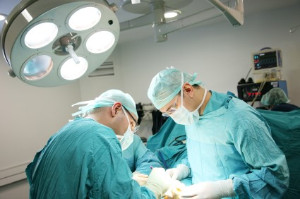 Freshman player Jarred Vanderbilt of the University of Kentucky will likely need surgery after sustaining an injury in his left foot. He is expected to be out for three months and will likely return in January. Vanderbilt was a former 5-star recruit and was the 12th-ranked player out of all 2017 recruits. Sustaining such a big injury this early in his career is tough. Vanderbilt, however, remains optimistic about the surgery and his return.
Freshman player Jarred Vanderbilt of the University of Kentucky will likely need surgery after sustaining an injury in his left foot. He is expected to be out for three months and will likely return in January. Vanderbilt was a former 5-star recruit and was the 12th-ranked player out of all 2017 recruits. Sustaining such a big injury this early in his career is tough. Vanderbilt, however, remains optimistic about the surgery and his return.
Foot surgery is sometimes necessary to treat a foot ailment. To learn more, contact one of our podiatrists of Livingston Footcare. Our doctors will assist you with all of your foot and ankle needs.
When Is Surgery Necessary?
Foot and ankle surgery is generally reserved for cases in which less invasive, conservative procedures have failed to alleviate the problem. Some of the cases in which surgery may be necessary include:
What Types of Surgery Are There?
The type of surgery you receive will depend on the nature of the problem you have. Some of the possible surgeries include:
Benefits of Surgery
Although surgery is usually a last resort, it can provide more complete pain relief compared to non-surgical methods and may allow you to finally resume full activity.
Surgical techniques have also become increasingly sophisticated. Techniques like endoscopic surgery allow for smaller incisions and faster recovery times.
If you have any questions please feel free to contact our office located in North Brunswick, NJ . We offer the newest diagnostic and treatment technologies for all your foot and ankle needs.
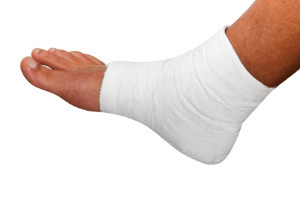 Baltimore Ravens defensive end Brent Urban sprained his foot during a game against the Jacksonville Jaguars. As if the injury wasn’t already bad news, his return this season is questionable. Urban’s injury also puts the Ravens defensive line into a precarious situation, with Brandon Williams, Chris Wormley, and Bronson Kaufusi all inactive. The Ravens’ loss of 44 to 7 is a poor showing this early in the season.
Baltimore Ravens defensive end Brent Urban sprained his foot during a game against the Jacksonville Jaguars. As if the injury wasn’t already bad news, his return this season is questionable. Urban’s injury also puts the Ravens defensive line into a precarious situation, with Brandon Williams, Chris Wormley, and Bronson Kaufusi all inactive. The Ravens’ loss of 44 to 7 is a poor showing this early in the season.
Sports related foot and ankle injuries require proper treatment before players can go back to their regular routines. For more information, contact one of our podiatrists of Livingston Footcare. Our doctors can provide the care you need to keep you pain-free and on your feet.
Sports Related Foot and Ankle Injuries
Foot and ankle injuries are a common occurrence when it comes to athletes of any sport. While many athletes dismiss the initial aches and pains, the truth is that ignoring potential foot and ankle injuries can lead to serious problems. As athletes continue to place pressure and strain the area further, a mild injury can turn into something as serious as a rupture and may lead to a permanent disability. There are many factors that contribute to sports related foot and ankle injuries, which include failure to warm up properly, not providing support or wearing bad footwear. Common injuries and conditions athletes face, including:
Sports related injuries are commonly treated using the RICE method. This includes rest, applying ice to the injured area, compression and elevating the ankle. More serious sprains and injuries may require surgery, which could include arthroscopic and reconstructive surgery. Rehabilitation and therapy may also be required in order to get any recovering athlete to become fully functional again. Any unusual aches and pains an athlete sustains must be evaluated by a licensed, reputable medical professional.
If you have any questions please feel free to contact our office located in North Brunswick, NJ . We offer the newest diagnostic and treatment technologies for all your foot and ankle needs.
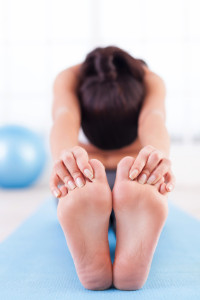 Many people spend a lot of time exercising. Often, they wind up working out every part of their body but their feet. While it may not seem important, having strong feet improves balance and mobility, and promotes overall body health. The following are some exercises that can help increase foot strength, with the approval of your podiatrist. Flexed-toe raises can be completed by first standing on a slanted board while holding onto something. Then, bring your heels off the ground while standing on the balls of your feet for 12-16 repetitions. Lifting each of your toes up separately 10 times each will help increase flexibility. After that, point all of your toes up in the air and then curl them in; do 20 of these for each foot. Foot crunches, which are done by picking your foot up and contracting the toe joints and heel together for 10 seconds, should be done with each foot six times. Finally, while standing, shift your weight to your left and pull at the ground with your right toes by scrunching them to move forward. Do this 10 times before switching to the opposite leg.
Many people spend a lot of time exercising. Often, they wind up working out every part of their body but their feet. While it may not seem important, having strong feet improves balance and mobility, and promotes overall body health. The following are some exercises that can help increase foot strength, with the approval of your podiatrist. Flexed-toe raises can be completed by first standing on a slanted board while holding onto something. Then, bring your heels off the ground while standing on the balls of your feet for 12-16 repetitions. Lifting each of your toes up separately 10 times each will help increase flexibility. After that, point all of your toes up in the air and then curl them in; do 20 of these for each foot. Foot crunches, which are done by picking your foot up and contracting the toe joints and heel together for 10 seconds, should be done with each foot six times. Finally, while standing, shift your weight to your left and pull at the ground with your right toes by scrunching them to move forward. Do this 10 times before switching to the opposite leg.
Exercising your feet regularly with the proper foot wear is a great way to prevent injuries and build strength. If you have any concerns about your feet, contact one of our podiatrists from Livingston Footcare. Our doctors can provide the care you need to keep you pain-free and on your feet.
Exercise for Your Feet
Exercise for your feet can help you gain strength, mobility and flexibility in your feet. They say that strengthening your feet can be just as rewarding as strengthening another part of the body. Your feet are very important, and we often forget about them in our daily tasks. But it is because of our feet that are we able to get going and do what we need to. For those of us fortunate enough to not have any foot problems, it is an important gesture to take care of them to ensure good health in the long run.
Some foot health exercises can include ankle pumps, tip-toeing, toe rises, lifting off the floor doing reps and sets, and flexing the toes. It is best to speak with Our doctors to determine an appropriate regimen for your needs. Everyone’s needs and bodies are different, and the activities required to maintain strength in the feet vary from individual to individual.
Once you get into a routine of doing regular exercise, you may notice a difference in your feet and how strong they may become.
If you have any questions please feel free to contact our office located in North Brunswick, NJ . We offer the newest diagnostic and treatment technologies for all your foot and ankle needs.
 Biomechanics, or the study of mechanics in biological organisms such as humans, plays an important part in podiatry. Understanding the mechanics of the foot allows podiatrists to understand injuries, make proper diagnoses, and provide treatment strategies. For those who have foot injuries, podiatrists understanding the biomechanics of the feet lets them know if the injury is caused from impact, movement, or other variables. With the exact cause known, podiatrists can offer a number of solutions, such as orthotics, keeping pressure off the foot, and other methods to treat the condition. Biomechanics allows podiatrists to get a better understanding of our feet and how they work.
Biomechanics, or the study of mechanics in biological organisms such as humans, plays an important part in podiatry. Understanding the mechanics of the foot allows podiatrists to understand injuries, make proper diagnoses, and provide treatment strategies. For those who have foot injuries, podiatrists understanding the biomechanics of the feet lets them know if the injury is caused from impact, movement, or other variables. With the exact cause known, podiatrists can offer a number of solutions, such as orthotics, keeping pressure off the foot, and other methods to treat the condition. Biomechanics allows podiatrists to get a better understanding of our feet and how they work.
If you have any concerns about your feet, contact one of our podiatrists from Livingston Footcare. Our doctors can provide the care you need to keep you pain-free and on your feet.
Biomechanics in Podiatry
Podiatric biomechanics is a particular sector of specialty podiatry with licensed practitioners who are trained to diagnose and treat conditions affecting the foot, ankle and lower leg. Biomechanics deals with the forces that act against the body, causing an interference with the biological structures. It focuses on the movement of the ankle, the foot and the forces that interact with them.
A History of Biomechanics
Modern technological improvements are based on past theories and therapeutic processes that provide a better understanding of podiatric concepts for biomechanics. Computers can provide accurate information about the forces and patterns of the feet and lower legs.
Understanding biomechanics of the feet can help improve and eliminate pain, stopping further stress to the foot.
If you have any questions please feel free to contact our office located in North Brunswick, NJ . We offer the newest diagnostic and treatment technologies for all your foot and ankle needs.
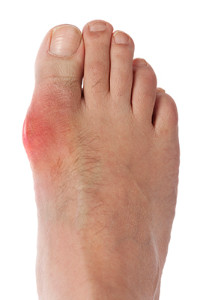 Gout, a type of arthritis, can be very painful for those who suffer from it. It’s caused when uric acid crystals build up in the joint, creating inflammation and pain. Gout, often occurring in the feet, generally comes and goes; there are ways, however, to mitigate its effects. Certain foods, such as processed meats, canned fish, foods with high fructose corn syrup, and foods containing high levels of purine should be avoided. Alcohol can increase the likelihood of gout, with as little as two beers a day increasing the risk significantly. Obesity is linked as well; losing weight, exercising, hydrating with plenty of water, and eating healthy foods can decrease the likelihood of a gout attack. If you are experiencing pain and inflammation in the foot, see a podiatrist for a diagnosis and treatment. Gout can be painful, but it can be avoided.
Gout, a type of arthritis, can be very painful for those who suffer from it. It’s caused when uric acid crystals build up in the joint, creating inflammation and pain. Gout, often occurring in the feet, generally comes and goes; there are ways, however, to mitigate its effects. Certain foods, such as processed meats, canned fish, foods with high fructose corn syrup, and foods containing high levels of purine should be avoided. Alcohol can increase the likelihood of gout, with as little as two beers a day increasing the risk significantly. Obesity is linked as well; losing weight, exercising, hydrating with plenty of water, and eating healthy foods can decrease the likelihood of a gout attack. If you are experiencing pain and inflammation in the foot, see a podiatrist for a diagnosis and treatment. Gout can be painful, but it can be avoided.
Gout is a foot condition that requires certain treatment and care. If you are seeking treatment, contact one of our podiatrists from Livingston Footcare. Our doctors will treat your foot and ankle needs.
What Is Gout?
Gout is a type of arthritis caused by a buildup of uric acid in the bloodstream. It often develops in the foot, especially the big toe area, although it can manifest in other parts of the body as well. Gout can make walking and standing very painful and is especially common in diabetics and the obese.
People typically get gout because of a poor diet. Genetic predisposition is also a factor. The children of parents who have had gout frequently have a chance of developing it themselves.
Gout can easily be identified by redness and inflammation of the big toe and the surrounding areas of the foot. Other symptoms include extreme fatigue, joint pain, and running high fevers. Sometimes corticosteroid drugs can be prescribed to treat gout, but the best way to combat this disease is to get more exercise and eat a better diet.
If you have any questions please feel free to contact our office located in North Brunswick, NJ . We offer the newest diagnostic and treatment technologies for all your foot and ankle needs.